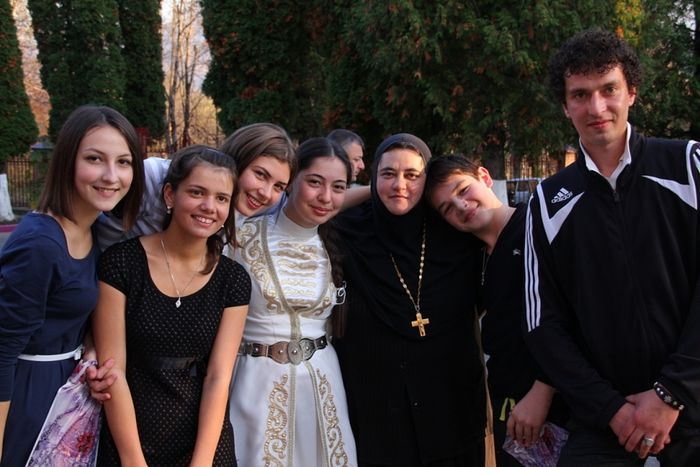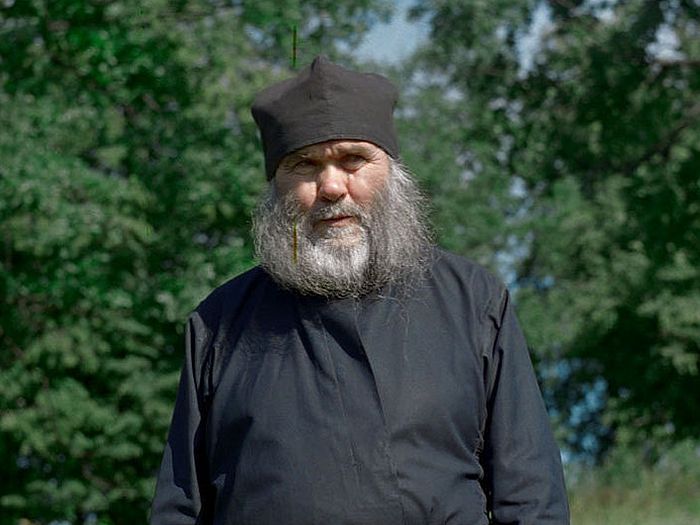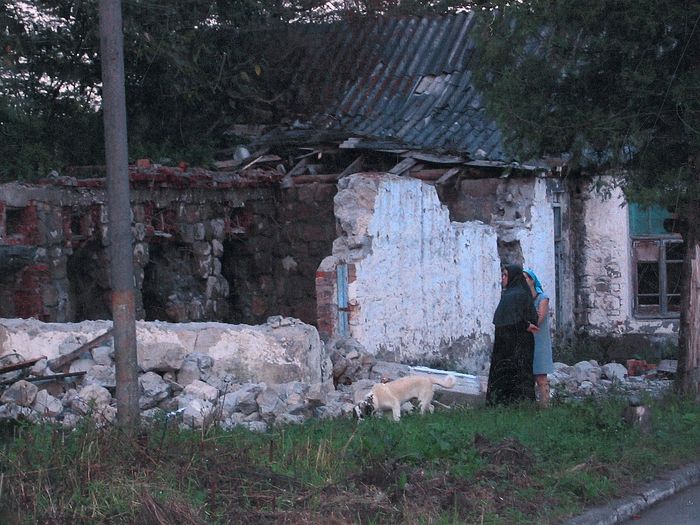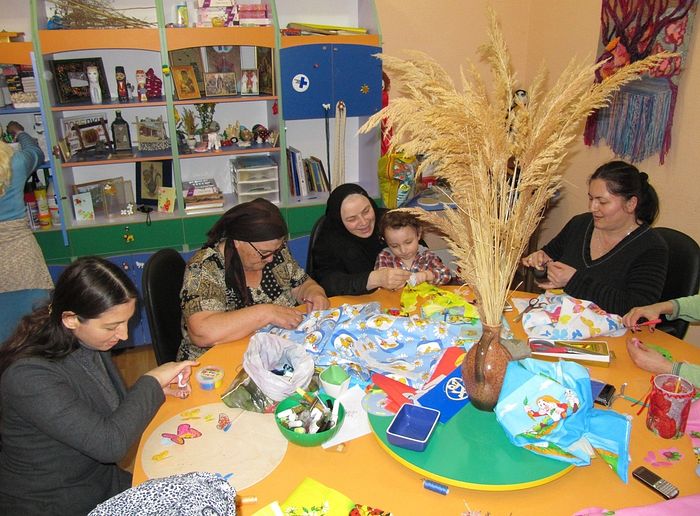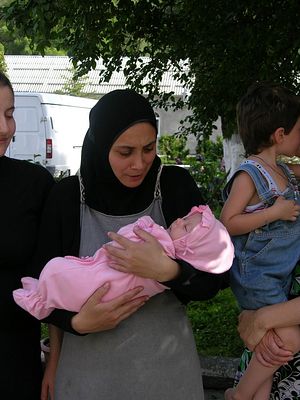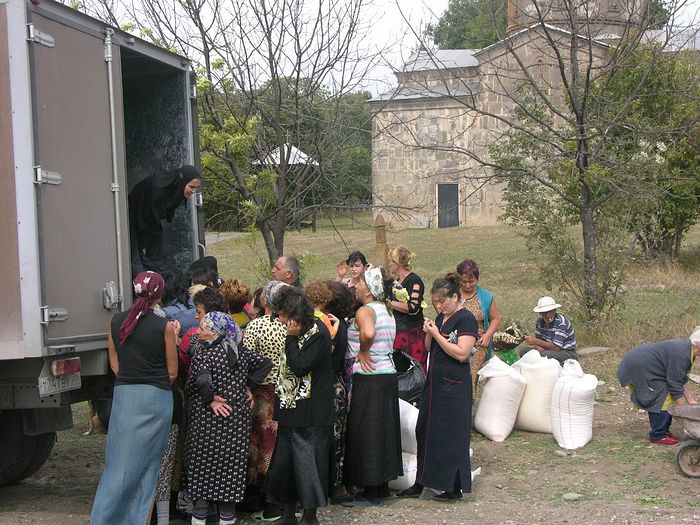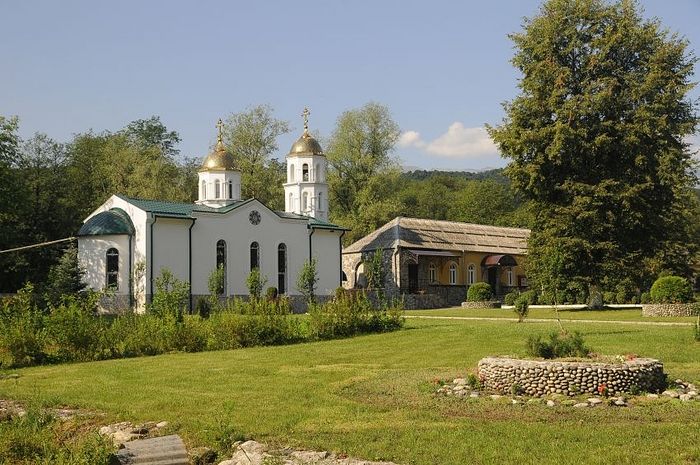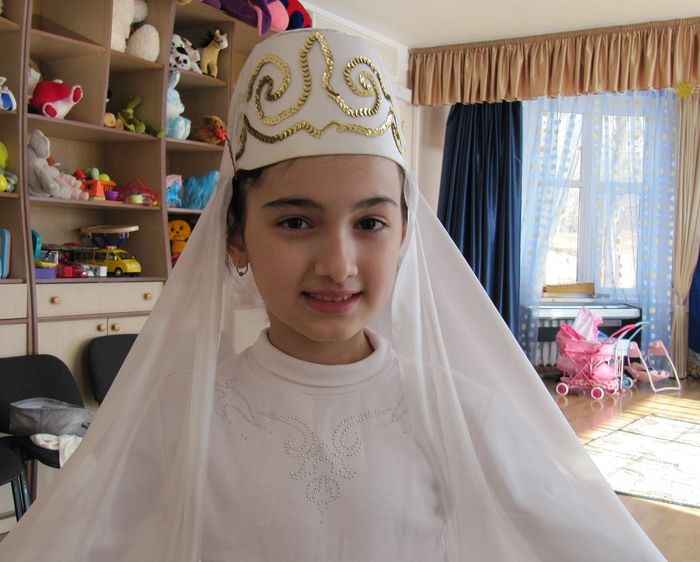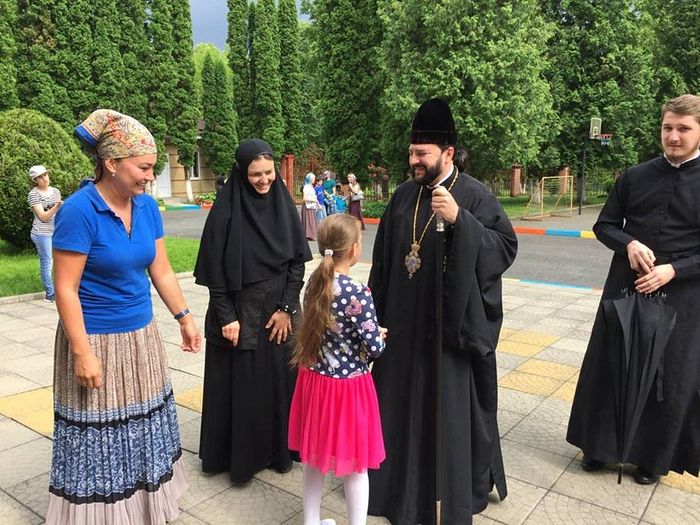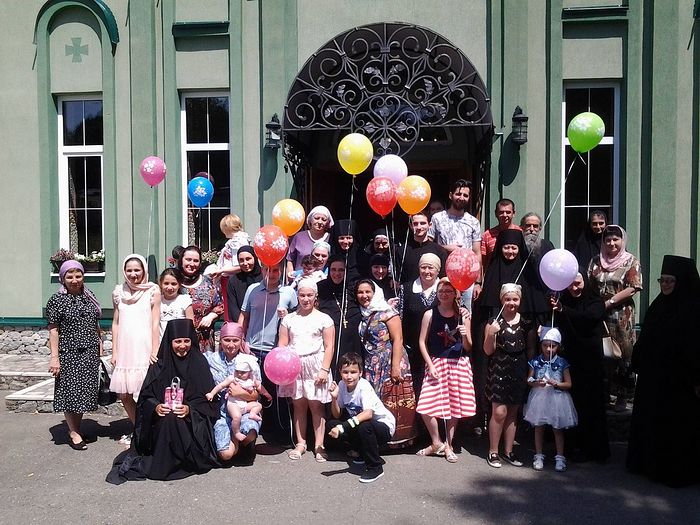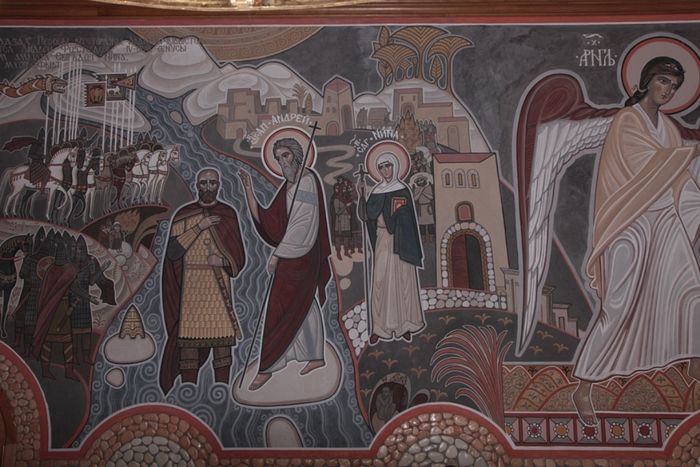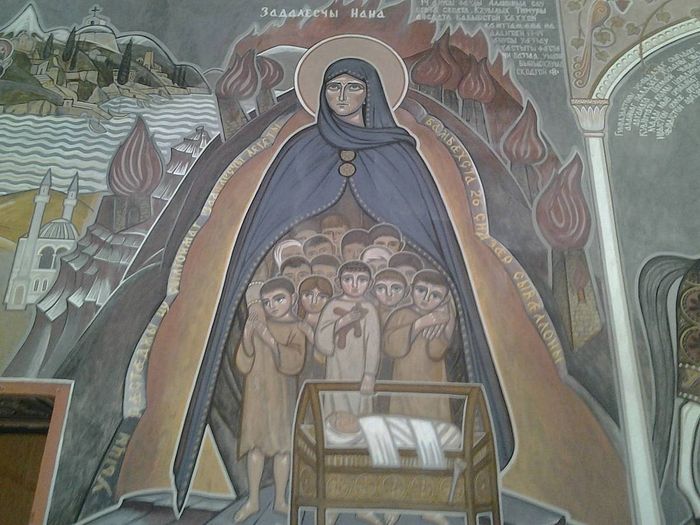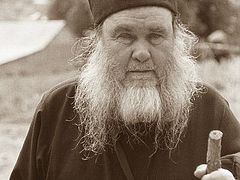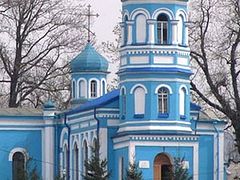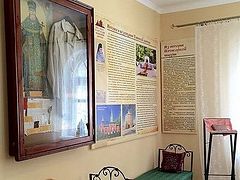Alania Convent of the Theophany is an outpost on the way to the Alagir Gorge, on the road connecting North Ossetia and South Ossetia. This young convent became a real spiritual center not only in Ossetia but in the whole of the Caucasus. It is no coincidence that a rehabilitation center for children-victims of the 2004 Beslan terrorist attack and refugees from South Ossetia was founded here.
Thanks to the labors of its nuns, liturgical texts in Ossetian are being published. Pilgrims and visitors feel the grace of God and the love of the nuns, which is present in each stone, in each flower-bed, each hazel tree and apple tree, each prayer for their native Ossetian land, the Caucasus, and the whole of Russia. Indeed this convent is a model of Orthodoxy in this ancient land of Alania.
“When you are busy helping children and people in trouble, you become healthy again”
I talked with Mother Nonna (Bagayeva), the convent’s abbess, in the convent’s yard on her birthday. We were standing by the monument to the much-venerated elder, Hippolytus (Khalin; 1928-2002), who was abbot of the Rylsk-St. Nicholas Monastery in the Kursk region and father-confessor of the Theophany Convent’s community. The sound of prayers in Church Slavonic and Ossetian were coming from the Church of the New Martyrs Elizabeth Feodorovna and Barbara. Every now and then people coming from all over Ossetia to greet Abbess Nonna would interrupt our long conversation. She embraced everybody with affection, greeted and blessed them on their departure. But the guests kept coming…
Mother Nonna, a historian, director of the Ossetian television, and presenter of the “Portrait against a Background of Mountains” TV program, spoke about her path to monastic life, and how she once went to Rylsk Monastery to meet with Elder Hippolytus, simply as a new character for her program. The short yet heartfelt conversations with the elder and his prayers determined her future life path.
“Having stepped over the threshold of the Church, I discovered a life that I hadn’t known before then. Time, space, and all the values were absolutely different. While I knew very little about Orthodox Christianity, I realized that there was something unique and different about it, something that I wanted to get to know better and be part of. My first impressions of Rylsk Monastery tallied with what my father (who was not baptized at that time) had taught me: to avoid self-seeking and careerism, and to have simplicity in relationships. Not the simplicity that is worse than robbery (as a Russian saying goes); rather, the simplicity that stems from great wisdom and a desire to humble yourself before God and your neighbors. I realized that I wanted to be in that environment.”
In 2002, Mother Nonna received the tonsure after Elder Hippolytus had blessed her not only to become a nun but also to found a convent in Alagir [a town in the republic of North Ossetia, Russia].
“I meant to move to Stanitsa Arkhonskaya, where a community of Cossacks lived, hoping that it would be easier for us to live alongside Orthodox believers. But the elder pounded the table and said: ‘Upper Ossetia! There is an abandoned rest home some four miles away from you—it will be the territory of the future convent. Pray hard—and the Lord will guide you.’ He added that we would have a house and supplies of fish there. His words made me laugh: how would we have fish in the foothills?!
“During the terrible Kolka ice slide at the Karmadon Gorge in 2002, a group of pilgrims from Ossetia was visiting Rylsk Monastery. People were terrified, it was rumored that the ice had swept away entire villages in the plain. We dashed towards the elder with our fears and he predicted: ‘The worst is yet to happen! The entire world will mourn for you!’”
The sisters arrived to Alagir in May 2002 and settled down in an unfinished house that had been purchased with the blessing of Fr. Hippolytus by his spiritual children in the middle of a town street. The nuns had an enormous amount of work to do in the new place, though their experience in construction and financial resources were very modest. But the sisters weren’t afraid of difficulties: their hearts were burning with the desire to lead the monastic life in their native land and pray for the whole of the Caucasus. In December of the same year their beloved elder fell asleep in the Lord.
The sisterhood lived in Alagir until 2004. When Vladyka Theophan (now Metropolitan of Kazan and Tatarstan) was transferred to the Diocese of Stavropol and Vladikavkaz, the community’s life changed. The bishop said that the sisters should look for a new home as living in a city street is not good for monastics. After he had appealed to the head of the district the sisters were given around thirty-seven acres of land with dilapidated buildings of a former sanitarium three miles away from Alagir.
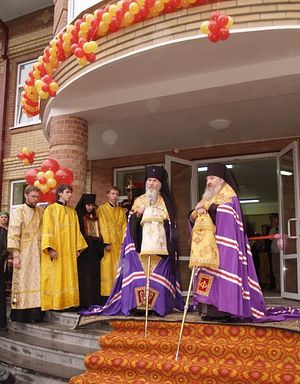 The opening of the center. Archbishop Theophan (Ashurkov) of Stavropol and Vladikavkaz with Archbishop Mark (Arndt) of Berlin and Germany
The opening of the center. Archbishop Theophan (Ashurkov) of Stavropol and Vladikavkaz with Archbishop Mark (Arndt) of Berlin and Germany At that time the sisters were unaware of what they should be fearing.
“There was neither light, nor gas, nor water, nor windows… We would lean an old wardrobe against the door at night and hear dogs running along the corridor. That was scary; but what really terrified us were the terrorist attack in Beslan and the war in South Ossetia. We came here in July, and in September everybody was devastated by the tragedy in Beslan, so we didn’t have time to think about ourselves.”
The Convent of the Theophany appeared at the time of the Beslan tragedy. It is no mere chance that the Lord chose this convent for consoling the Beslan hostage crisis victims and healing their distress.
On September 1, 2004, a group of Chechen terrorists sieged a school in Beslan. 1,128 people were taken hostage. 334 people were killed, including 186 children. These are the official statistics. But this massacre was followed by heart attacks, strokes, suicides and other deaths, which were a continuation of the tragedy in Ossetia. In the first days it became clear that the mental traumas of the siege survivors would take long to heal. A lot of time, efforts, and, above all, love were needed.
“The next day after the school siege many residents of Beslan began coming to us asking: ‘Where was your God during the tragedy?’ I could neither cry nor pray at that time; nor did I have an answer to their question. I fell into such a stupor that there was only pain and a total loss of strength. Later I asked our friend, Archpriest Andrei Sikoev (who together with Metropolitan Theophan conceived the idea of establishing a rehabilitation center for the victims of Beslan), the same question, and he replied without a moment’s thought: ‘Christ was there in the gym with the hostages.’”
Mother Nonna recalls how her convent’s sisters who then were not spiritually mature had to assume the roles of comforters, psychologists, teachers, crisis and social workers. Several days after the massacre, Metropolitan Theophan came to their convent with a priest whom they had never met before. It was Fr. Andrei Sikoev from Berlin, an Ossetian by birth. On the third day after the terrorist attack with the blessing of the Church Hierarchy he brought an aircraft full of up-to-date medical equipment purchased with donations of the ROCOR parishes all over the world.
At that time the sisterhood consisted of ten nuns, and four of them were elderly. The experience they acquired by serving people was truly unique.
“Nobody forced us to found this rehabilitation center for children; we just wanted to save ourselves. We felt that if we didn’t help Beslan we would certainly go insane from grief. And when you are busy helping these children and people in trouble, you become healthy again. As you see a child’s smile you smile back. As you see a woman who has lost her child take Communion and pray, you receive healing yourself. You begin to breathe.”
The construction of the rehabilitation center was a historic event in the life of the Church: It was the first joint project of two dioceses, those of Berlin (ROCOR) and the Vladikavkaz (the Patriarchate), though it was before the 2007 rapprochement. Through the prayers of two Russian Orthodox hierarchs, Theophan of Stavropol and Vladikavkaz and Mark of Berlin and Germany, the center was completed and equipped in less than two years.
“It was difficult for us to build the convent and admit children to the rehabilitation center simultaneously. But I have no regrets about doing it. I saw the will of God in this and it was the obedience of the convent’s sisters.”
Today the Convent of the Theophany is known all over Ossetia for its works of mercy, and the nuns know hundreds of children and families in Beslan. The medical and psychological aid in combination with the striking beauty of nature, the sense of prayer and silence, the grace of God, and the nuns’ abundant love proved salutary for the tragedy’s survivors.
“We would receive whole classes with their teachers. Mothers who gave birth to babies after the Beslan siege would come to us. Our parishioner and friend, Marina Pak, lost her only daughter, Svetlana Tsoy, in the terrorist attack. And Marina adopted a six-year-old boy. He grew up before our very eyes.
“All the school students that were taken hostage in September 2004 have already grown up, and we still keep in touch with them. Many of them are married and they have first-hand knowledge of what monasteries, the life in them, and monastics are like, how to enter the church, how to pray, rejoice, sympathize with others, and love. The nuns and the rehabilitation center’s workers tried their best to ensure that the people who had seen hell with their own eyes see this world as kind, and its people as loving.”
Nobody could have imagined that four years later the Ossetians would be once again shaken by pain and torment, and the sisters of the Theophany Convent would be on the front line again. In August 2008 war came to South Ossetia.
Mother Nonna recalls the first days of the war and shelling of the neighboring Tskhinvali:
“The unceasing bombardment of Tskhinvali did not surprise us as it was frequently under fire. We weren’t aware of the beginning of war because we had neither the internet, nor telephone, nor radio, nor TV at the convent. We learned that Tskhinvali was being shelled by the ‘Hail’ mobile artillery rocket systems from migration service officers and military officials early in the morning of August 8, when they came and asked us how many refugees we were able to accommodate. The internet was installed at our convent within one day. Metropolitan Theophan blessed us to receive refugees, and we prepared 100 places at the rehabilitation center right away, though it was only intended for twenty-five. We cleared all the rooms that we could clear. Then military surgeons came and requested a room for lightly wounded people from us because the hospital couldn’t handle all the casualties. We prepared a room with twelve beds for them. We organized the provision of nourishment on the road to Tskhinvali very quickly. The refectory worked like a conveyor belt—we fed everybody. Next the servicemen set up a base nearby. We provided them with water and materials to make fires. We did our best to help them. Our convent served as a center where all the ‘transit’ refugees stopped; we also organized the search for missing people. All of this had been done by August 9. On that day I left for South Ossetia in order to better understand what more my sisters and I could do for its people. And we were caught in an air raid there.”
On their way back to the convent, Mother Nonna and her sisters saw a woman with eight children on the road. It was a large family. The father with two sons had stayed in Tskhinvali, and the mother with all the other children fled the war. Mother Nonna took all of them to the convent. Later, when the boys reunited with their family, they used to tell everybody that “a woman in black with a large cross in her hands” saved their sisters and younger brothers.
The convent became the hub for humanitarian aid as well. Donors and all who didn’t remain indifferent to the tragedy of South Ossetian residents sent parcels to the convent, and the nuns would distribute batches among those in need. When refugees returned to South Ossetia, the sisters would deliver humanitarian aid through a mountain pass, distributed it in Tskhinvali, and visited dozens of villages between September and December.
“The refugees whom we sheltered in our convent still come and visit us. We maintain friendly relations and many of them became our godchildren, though it is out of line with monastic tradition. At that time finding godparents was next to impossible, so each of us is a ‘mother’. The youngest of our refugees was then one month old. Now Alina is ten and she enjoys visiting our convent.
“They come over every time they are en route from South Ossetia. They always bring us tasty cheese and wine from the south. For me the expression, ‘if only there were no war’, is not mere words—this is what I really experienced in life. As you think of and pray for the soldiers who were killed (while an agreement could have been reached by peaceful means), you come to realize that the parties that unleashed the war will sooner or later sit down at the bargaining table, smile to each other, and shake hands with one another, while all of these young men are gone for good; so you feel very bitter.”
The life of the rehabilitation center today
Mother Georgia (Bestaeva), assistant abbess of the convent and Director of the Children’s Rehabilitation Center of St. Elizabeth the New Martyr, joined in our long conversation. She led us to the convent’s holy lakes and pointed at the building of the rehabilitation center, hidden behind leaf-bearing trees, saying, “This is our little paradise!” Indeed this is what the “paradise on earth” for healing children’s distress and anguish should look like.
Mother Georgia with deep regret noted that the center no longer functions fully as it did before. There is no financial support. Initially the program for the rehabilitation of the victims of Beslan was supposed to last two years; it was financed by German Children’s Fund and the ROCOR Diocese of Berlin and Germany. According to the agreement, on completion of the program the convent could use the center at its own discretion. But Beslan survivors still needed help and sought admission. Additionally, social services and schools appealed to the center to help children with difficult life situations.
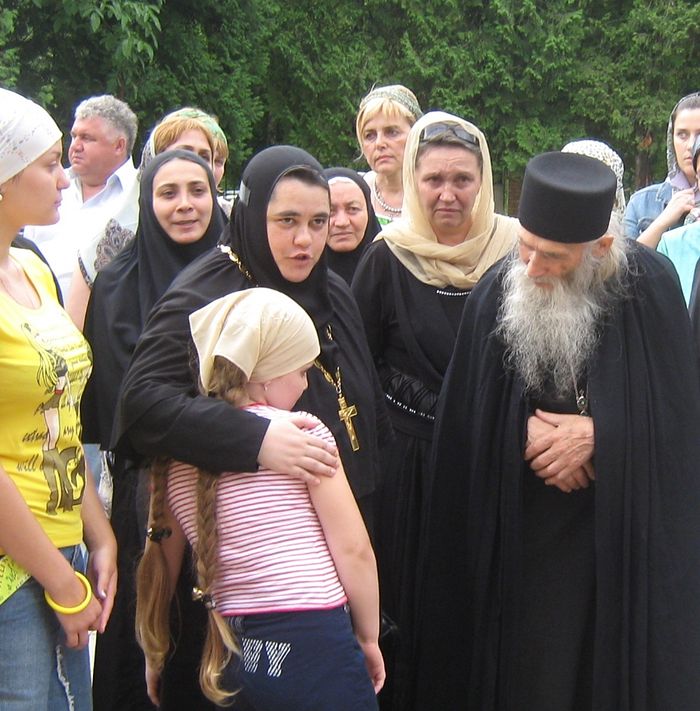 Mother Nonna leads Tamila, daughter of the killed teacher Alena Dzutseva, up to take Elder Iliy’s blessing
Mother Nonna leads Tamila, daughter of the killed teacher Alena Dzutseva, up to take Elder Iliy’s blessing And the sisters resolved to continue with their work, although they couldn’t imagine how they would deal with this problem financially.
“I remember Mother Nonna saying: ‘It was God Who charged us with this obedience. The center was built and equipped earlier than the church.’ Thus the Lord showed His will. Without any financial prospects the center’s work never ceased. Money came as if from nowhere. First a good friend of ours donated a considerable sum of money to the convent in memory of his mother who had been killed in the Tskhinvali shelling; then another convent’s friend sent a charitable foundation to us from the faraway Khanty-Mansi Autonomous Area. Afterwards we received state support in accordance with the nonprofit organizations financing program.”
Between 2007 and 2015 the center worked year-round, and over its ten years of work it admitted more than 6,000 children of different ages.
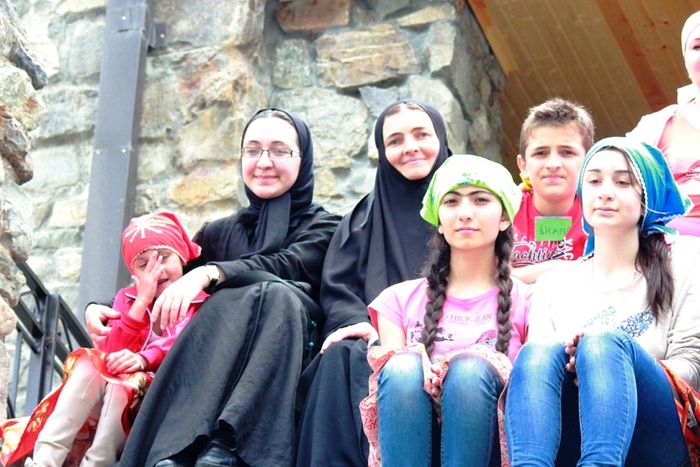 A pilgrimage to the Holy Dormition’s Monastery. Aida and Dana (in the foreground) are former hostages. Now they are students
A pilgrimage to the Holy Dormition’s Monastery. Aida and Dana (in the foreground) are former hostages. Now they are students Since 2009 the center has received a large number of applications from different regions of South and North Ossetia to help and support children from families in difficult life situations, single-parent families, children under care of their grandparents, families with dependent parents or mentally ill members. There were appeals not only from relatives, but also from social centers. For many years the center has cooperated with the District Administration of Social Protection.
“We have never tried to find children ourselves; rather, they always came to us through their parents, kind people, teachers, and officials. As for us, we must obey the commandment of Christ: Give to him that asketh thee (Mt. 5:42). There were some remarkable stories. One day two children aged fifteen and nine respectively entered the convent right from the highway. They asked for matches. It turned out that they had run away from home. We allowed them to stay overnight and phoned the police. And two months later we were asked by a social service to receive a boy who had attempted suicide. It was the younger of the two boys from the highway we had sheltered two months earlier! When he was leaving the center several days later, we gave him a new ball. He was very happy but decided to leave it behind before his departure, saying that otherwise it would be lost. So even a ball was not safe in the conditions the boy had to live in. We will never forget this child’s pain. Afterwards we received children from that family for years at the convent (there are seven of them) and bought them new clothes and shoes. Their parents’ rights were recently restricted.”
Currently the center has no permanent source of funding—the financial crisis has affected donors as well. Despite this it still manages to find some funding for the organization of a work camp for adults and children with developmental delays, with the assistance of Moscow specialists.
Children with mental and emotional disturbances have been admitted to the center since 2012. With the blessing of Archbishop Leonid of Vladikavkaz and Alania a summer camp for mothers and children was organized. In this season, the convent’s friends along with psychologists from the “Workshops of Psychological Aid for Children” center in Moscow come here.
“The convent takes the organization of the camp and spiritual support upon itself, and psychologists give special lessons and provide counselling. Within one group we manage to advise as many as forty to forty-five families. Besides, we sculpt in clay every day. It is the group occupation that attracts children, mothers, and the center’s staff—everybody from tutors to guards. Perhaps the archbishop’s blessing accounts for its popularity. Archbishop Leonid even presented our club with a kiln for baking clay models.
“Applications for the participation in the camp are submitted long before summer. Actually, we do it in response to families’ requests. For most of the parents, visiting the convent is a personal need, a desire to get answers to all their questions, and grow stronger in faith.”
By tradition the camps are organized in May. Teenagers and young people from all over Ossetia come here to labor for the glory of God and help the sisters.
These are not “trudniki” (laborers) in strict sense. Even unchurched people or non-Christians may be members of these groups; what really matters is that they should be willing to labor and learn more about the Orthodox faith. Each subgroup is assigned to some specific work front—for example, men remove wind-fallen trees and shrubs in the forest and at the lakeside, and girls prepare the center and the adjacent territory for the reception of children. This place is like a second home to many people who have labored here.
The Theophany Convent’s sisters in the land of ancient Alania respect the precepts of their forebears, who converted to Christianity under the influence of Byzantium earlier than Kievan Rus’, preserving their faith and traditions. Today the convent is also an educational center for the whole of Ossetia. The nuns study Orthodox Ossetia’s past and share their knowledge and love for their native land with parishioners, pilgrims, and guests. They have been translating liturgical texts into The Ossetian language, and Ossetian artists in memory of Christian Alania have generously decorated the convent’s church and refectory walls with paintings.


